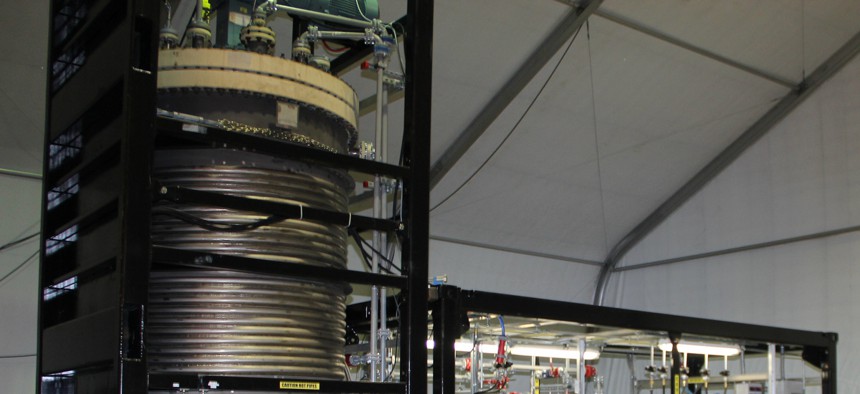
An example of the Field Deployable Hydrolysis System being displayed at the Edgewood Chemical Biological Center Photo courtesy of Edgewood Chemical Biological Center
How the U.S. Will Dispose of Syria's Chemical Weapons
Here are the details behind a complex process to remove -- and destroy -- Bashar al-Assad's most dangerous weapons. By Sara Sorcher
The U.S. narrowly avoided military action in Syria after Bashar al-Assad pledged to rid his country of chemical weapons. But now it appears that Washington, barring any better options, will have to destroy the most lethal elements of Syria's stockpiles. That process will be dangerous—and potentially very expensive.
As the U.S. awaits a formal international request to help destroy the Syrian material, which includes mustard gas, sarin, and VX, here's a detailed look at what that operation could involve.
TRANSPORT
Because countries—including Albania, Belgium, and Norway—declined to destroy Syria's arsenal on their own soil, the Organization for the Prohibition of Chemical Weapons said the U.S. offered to break down the most lethal components in international waters.
The global chemical-weapons watchdog hopes to see all the declared chemicals transferred to the coastline by the end of the year so they can be eliminated away from the bloody fighting in Syria. Yet the transit itself through the war-torn country will be risky.
"We're actually entering the most dangerous phase of this operation by far right now," said Amy Smithson, senior fellow at the James Martin Center for Nonproliferation Studies at the Monterey Institute of International Studies. "Because they're going to try to move bulk quantities of chemicals from a variety of different locations within Syria, through several different routes where they could come under a security threat from any of the warring parties in this conflict—for starters, al-Qaida and Hamas."
"It doesn't take a stretch of the imagination to recognize that if you capture a convoy that has mustard gas in it, then you've got a real war prize," Smithson continued. "And if it's a terrorist group, they might use it against the neighboring states."
THE BOAT
In Norfolk, Va., the U.S. is modifying a 648-foot-long transport vessel, the MV Cape Ray, to include chemical-arms destruction gear. The Field Deployable Hydrolysis System is approximately 400 feet by 700 feet and includes power generators, hazardous-waste storage, and a laboratory. The system, meant to easily ship in approximately 35 20-foot containers, needs only consumable materials such as water, reagents, and fuel to run.
The system was commissioned on a short time line. Initiated in February, the first unit was delivered by July—though, as a Defense official noted, it was not developed "specifically" for Syria's looming proliferation crisis.
When the ship is under way, it will likely be under the military's Sealift Command, for which typical missions include resupplying American carrier groups with fuel and food supplies. It remains unclear whether military or civilian personnel will carry out the disposal operation.
DESTRUCTION
Destroying the chemical materials, according to OPCW Director-General Ahmet Üzümcü, is expected to cost between $47 million and $61 million, though this estimate does not necessarily include the price of the system, transporting the stocks, or disposing of the toxic waste afterward.
"We are working on determining costs," a Defense Department official says, "but we are obviously in the process of starting those modifications [on the Cape Ray] so we will have more firm cost figures soon."
Here's what that money will go toward: destroying an estimated 500 tons of chemical-warfare agents considered too dangerous to bring into another country. The hydrolysis system is meant to neutralize the agents in bulk with reagents (such as water, sodium hydroxide, and sodium hypochlorite) by combining them in a reactor, heating the mix, and allowing the substances to react before removal.
This complex operation is hazardous, even on a boat, said chemist Ralf Trapp, formerly with the OPCW, who works as an arms-control consultant. "People will have to operate with protective gear, decontamination equipment, in case something goes wrong or someone goes into a contaminated zone. They will have to have sensors on board," he said.
The hydrolysis technology has been proven and used by the U.S. in destruction of its own stocks in the Army's Aberdeen Proving Ground in Maryland, and in Newport, Ind. While it was not designed to be deployed on a boat, the Defense official said, "it's certainly feasible."
The process, which can neutralize five to 25 metric tons of chemical warfare agents a day, also creates liquid hazardous waste—roughly five to 14 times the quantity of the treated material.
"What are you going to do with that [liquid industrial waste]? Dump it in the ocean? Obviously not," OPCW spokesman Michael Luhan said. "That could be disposed of by private companies subcontracted by the U.S. government."
COMMODITY CHEMICALS
The U.S. government won't destroy all of Syria's arsenal, however.
Some 800 tons are what's considered commodity chemicals—substances that can serve as precursor chemicals for weapons of mass destruction, but are also found in standard industrial uses and therefore considered safe to destroy in commercial facilities.
Because these substances were "all part of a production chain whose end-point was to make chemical weapons," Luhan said, "they all have to be destroyed.… If some of these chemicals were being used to make pharmaceuticals or some other legitimate purpose, they could remain in Syria."




